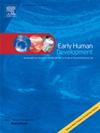Iron deficiency in pregnancy and its association with blood lead and manganese levels in offspring in Benin, Sub-Saharan Africa
IF 2
3区 医学
Q2 OBSTETRICS & GYNECOLOGY
引用次数: 0
Abstract
Introduction
The impact of prenatal iron deficiency (ID) on offspring's blood lead level (BLL) and blood manganese level (BML) in infancy remains poorly understood. This study aimed to assess associations between prenatal ID and BLL/BML in offspring in Benin. We also investigated associations between infant ID and corresponding BLL and BML in infants.
Materials and methods
Data on hematological parameters, metal blood concentrations, and socioeconomic status were obtained from a prospective mother-child cohort study in Allada, Benin. Blood samples were collected during pregnancy (n = 501), at delivery (n = 501), and from 12-month-old infants (n = 501) to assess iron deficiency and haemoglobin concentration. Additionally, BML was analyzed for a subset of 12-month-old infants (n = 271), and BLL was determined for the full cohort of 12-month-old infants (n = 501). Associations between ID and metal concentrations were examined using logistic regressions.
Results
Prenatal ID and IDA at the first and third antenatal care visit (ANC) were positively associated with infant BLL above 50 μg/L. Infants of mothers with prenatal ID and IDA had higher BLL. Moreover, prenatal ID and IDA at first and second ANC visits were positively associated with higher infant BML. In infancy, infants with ID and IDA had significantly higher BLL as compared to those without ID and IDA. Infant ID and IDA were positively associated with elevated BLL.
Conclusion
Elevated BLL and BML in infants were positively associated with ID and/or IDA prenatally during at least one ANC visit, while in infancy, infant ID and IDA were positively associated with elevated BLL only. Infants with ID and IDA showed higher BLL but not BML. This suggests that ID prenatally and during infancy may contribute to high blood lead concentrations in infants, which can lead to neurotoxicity. Treating ID and IDA is critical to prevent toxicity caused by high BLL in infants.
撒哈拉以南非洲贝宁孕妇缺铁及其与后代血铅和锰水平的关系
产前缺铁(ID)对子代婴儿期血铅(BLL)和血锰(BML)水平的影响尚不清楚。本研究旨在评估贝宁产前ID与后代BLL/BML之间的关系。我们还研究了婴儿ID与相应的BLL和BML之间的关系。材料和方法从贝宁Allada的一项前瞻性母婴队列研究中获得血液学参数、血液金属浓度和社会经济地位的数据。在怀孕期间(n = 501)、分娩时(n = 501)和12个月大的婴儿(n = 501)采集血液样本,以评估铁缺乏和血红蛋白浓度。此外,还分析了12个月大婴儿的BML子集(n = 271),并确定了整个12个月大婴儿队列(n = 501)的BLL。使用逻辑回归检验了ID和金属浓度之间的关系。结果第一次和第三次产前检查(ANC)时的产前ID和IDA与50 μg/L以上的婴儿BLL呈正相关。产前ID和IDA母亲的婴儿有较高的BLL。此外,第一次和第二次ANC就诊时的产前ID和IDA与较高的婴儿BML呈正相关。在婴儿期,有ID和IDA的婴儿的BLL显著高于无ID和IDA的婴儿。婴儿ID和IDA与BLL升高呈正相关。结论在至少一次ANC就诊期间,婴儿BLL和BML升高与产前ID和/或IDA呈正相关,而婴儿ID和IDA仅与BLL升高呈正相关。ID和IDA患儿的BLL较高,但BML不高。这表明,产前和婴儿期的铅血症可能导致婴儿血铅浓度升高,从而导致神经毒性。治疗ID和IDA对于预防婴儿高BLL引起的毒性至关重要。
本文章由计算机程序翻译,如有差异,请以英文原文为准。
求助全文
约1分钟内获得全文
求助全文
来源期刊

Early human development
医学-妇产科学
CiteScore
4.40
自引率
4.00%
发文量
100
审稿时长
46 days
期刊介绍:
Established as an authoritative, highly cited voice on early human development, Early Human Development provides a unique opportunity for researchers and clinicians to bridge the communication gap between disciplines. Creating a forum for the productive exchange of ideas concerning early human growth and development, the journal publishes original research and clinical papers with particular emphasis on the continuum between fetal life and the perinatal period; aspects of postnatal growth influenced by early events; and the safeguarding of the quality of human survival.
The first comprehensive and interdisciplinary journal in this area of growing importance, Early Human Development offers pertinent contributions to the following subject areas:
Fetology; perinatology; pediatrics; growth and development; obstetrics; reproduction and fertility; epidemiology; behavioural sciences; nutrition and metabolism; teratology; neurology; brain biology; developmental psychology and screening.
 求助内容:
求助内容: 应助结果提醒方式:
应助结果提醒方式:


